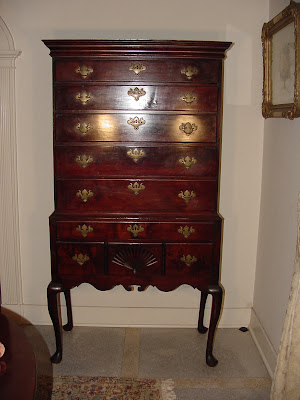So when I was asked to appraise an estate with a nice varied collection of American, English and European antiques recently, I reveled in the challenge.
In this collector's estate was a fine example of an American Colonial Queen Anne walnut highboy. Its regional characteristics hinted at a CT origin. It was structurally sound. More exciting was the fact that it retained its original pine secondary woods and brass hardware! Regrettably, it was refinished - probably in the early 20th Century. In American furniture, changing the original finish represents a diminution of collector desirability and therefore of value. But this does not indicate that the piece was at all undesirable. Far from it!
The highboy is characterized by a fine proportion. It is surmounted by a simple flat top with a moulded cornice over 5 overhanging wide
drawers in the upper body.
The lower half has an upper wide
drawer over a row of 3 drawers of which the central drawer has a
finely carved fan. The lower case is decorated with a down swept scrolled apron and rests on 4 somewhat heavy handed cabriole legs
terminating in pad feet.
The piece is not without a desirable and valuable provenance. It was
acquired by the late client whose estate I was engaged to appraise recently in 2010. He acquired it upon the death of his wife in 1981. And according to
family oral tradition it was owned by her family since the 18th
Century when it was made for her direct ancestor William Hooper (1742-1790) who was a signer
of the Declaration of Independence for North Carolina in 1776 whose image we see below. Not a bad pedigree!






No comments:
Post a Comment
Note: Only a member of this blog may post a comment.